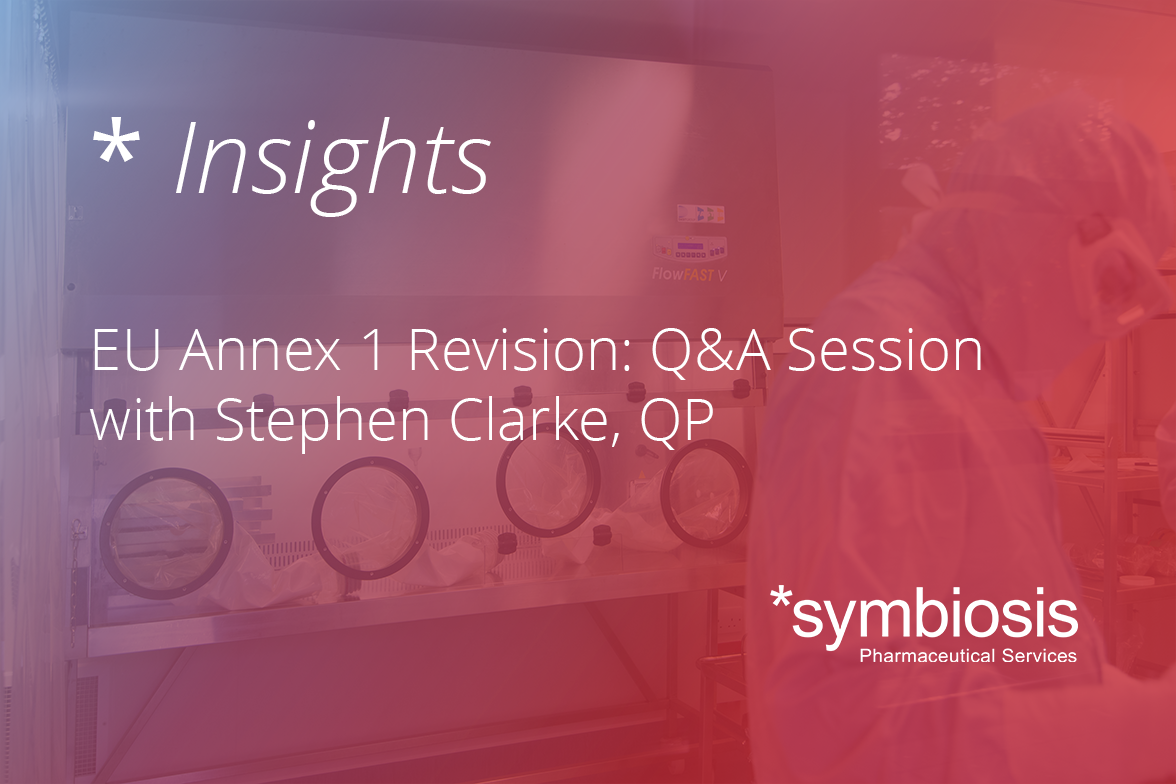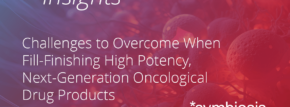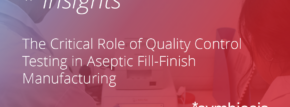EU GMP and Annex 1: The New Version
In this edition, we speak with Symbiosis Qualified Person, Stephen Clarke to learn about the new version of EU GMP and Annex 1 and the rules governing the manufacture of sterile medicinal products within the UK and Europe in this Q&A session.
The new version of Annex 1 has been expanded considerably and now contains a strong focus on risk management and having a contamination control strategy and we speak with Stephen about the key points.
The revision of EU GMP Annex 1, Manufacture of Sterile Medicinal Products
The revision of EU GMP Annex 1, Manufacture of Sterile Medicinal Products was finalised in August of 2022 by the European Commission. The final draft has expanded the annex from 16 pages to 59 pages and includes new requirements as well as additional detail related to many of the requirements presented in the previous version of Annex 1 from 2007. This revision is a complete rewrite of the annex and was a joint EU, PIC/S (Pharmaceutical Inspection Co-operation Scheme), and WHO (World Health Organisation) project, with US FDA personnel actively involved. EU, PIC/S and WHO have all now implemented the text as their regulatory expectation, providing consistency across much of the globe on this important health topic.
In August 2022, the European Commission published a revision to Annex 1 “Manufacture of Sterile Medicinal Products” in EudraLex – Volume 4 – Good Manufacturing Practice (GMP) guidelines that will significantly impact manufacturers who wish to market their aseptically prepared products in the EU.
What is the revision of EU GMP Annex 1, Manufacture of Sterile Medicinal Products?
The European Commission has revised Annex 1 of the EU GMP guidelines, which covers the manufacture of sterile medicinal products. The revision aims to address current regulatory and technological developments in the field, whilst also removing ambiguities and inconsistencies contained within the previous version. The new guidelines came into operation on August 25, 2023, except for section 8.123, which has been postponed until August 25, 2024. The revision includes new requirements for environmental monitoring, process validation, and risk management.
Why is Section 8.123 different?
Section 8.123 puts greater emphasis on minimising operator intervention when loading / unloading Lyophilizers and was given a longer implementation date as it is a significant change that could involve re-designing the sterile suite for many companies.
What are the implications for Contract Manufacturing Organisations in relation to Annex One?
The revision of EU GMP Annex 1 doesn’t have any implications specifically for CMOs, but does has significant implications for all fill-finish operations. The new guidelines require sites to have a clearly defined and frequently reviewed “Contamination Control Strategy” and also implement more rigorous environmental monitoring programs, including the use of continuous monitoring systems. The revision also requires us to test filters in a different way (Pre-Use, Post Sterilisation Integrity Testing or “PUPSIT” for short) and to ensure a risk-based approach to process control. Some companies need to invest in new equipment and technologies to comply with the new guidelines, which will increase costs.
Here are some of the questions around the new Annex 1 that Symbiosis have been asked by some of our clients.
What are the main new requirements for environmental monitoring in the revised EU GMP Annex 1?
The main differences for Environmental Monitoring are the requirement for continuous monitoring in the Grade A area, rather than the previous approach of monitoring discretely, and also the clarification that each individual reading for viable particle contamination should return a reading of “no growth” rather than the previous requirement whereby the expectation was an average reading of less than 1 colony forming unit. There is an additional expectation noted to select sampling locations and frequency based on the risk for each process. There is also a greater emphasis on characterising microorganisms if/when they are detected, in order to develop greater knowledge of what is in the room, and so continuously improve the relevant practices.
How will the revised EU GMP Annex 1 impact the quality of fill/finish processes?
With the revised EU GMP Annex 1 also being adopted as guidance on Sterile manufacturing of medicines by PIC/S and WHO this will lead to a greater standardisation of expectations, with the intent to improve the quality and safety of fill/finish manufacturing. The new guidelines require more rigorous environmental monitoring programs, greater awareness of filter effectiveness before use, and better documented risk management thinking, which will help to ensure that products are manufactured to the highest standards.
What are the implications of the revised EU GMP Annex 1 for emerging biotech companies?
Emerging biotech companies will need to comply with the new guidelines in order to manufacture sterile medicinal products. Compliance with the new guidelines could require investment in new equipment and technologies, which would increase costs. However, compliance will also help to improve the quality and safety of products, which could lead to increased demand and revenue.
Does this affect us if we manufacture outside of the EU?
These new regulatory expectations will affect all sterile drug (medicinal) products intended for EU markets, World Health Organisation (WHO) markets and markets that follow the Pharmaceutical Inspection Co-operation scheme (PIC/S) guidelines, even if they are manufactured outside of those territories. They are also relevant for the UK market, which continues to recognize EU GMP.
What are the equipment implications for parenteral companies?
New facilities requirements
RABS and isolators. Annex 1 establishes the use of Restricted Access Barrier Systems (RABS) or isolators as the expected minimal approach to aseptic processing. Section 4.3 indicates that their use should be considered in the CCS and any alternative approaches should be justified. Annex 1 does not explain what factors would justify the continued use of existing filling lines or whether newly constructed installations could justify alternative approaches to RABS or isolators. It is important to understand that these are different to each other. Isolators are completely closed, self-contained and can be operated in Grade D environments, whereas RABS are only partially closed and need to be used in Grade B. Each have different advantages and disadvantages depending on the facility, and also the drugs being handled.
There is also the requirement to maintain partially stoppered vials in a Grade A environment between filling and lyophilisation. This may require additional investment in the Facility or Equipment for some companies.
New criteria for aseptic processing
Grade A = “no growth.” The 2008 version of Annex 1 required that microbial growth for air and surfaces samples in Grade A areas must be less than 1 CFU. Because a colony forming unit (CFU) is necessarily an integer value, one could conclude that the requirement was actually zero (0) CFU. But Annex 1 described the values as averages, allowing for the rare excursion in an otherwise controlled Grade A area.
The revised Annex 1 (2022) sets the maximum action limit for viable particle contamination in Grade A areas at “No growth,” and indicates that “any growth should result in an investigation.”
Stricter success criteria for Media Simulations, now referred to as “Aseptic Process Simulations” (APSs). Annex 1 (2008) was aligned with FDA’s guidance, “Sterile Drug Products Produced by Aseptic Processing — current Good Manufacturing Practice” (September 2004) (“FDA’s Guidance”) in that the target for each APS was no media contamination in any filled vial. However, both FDA’s Guidance and Annex 1 (2008) required an investigation and consideration of repeating the APS if one contaminated unit was found for a simulation with more than 5,000 units.
The revised Annex 1 (2022) indicates that any contaminated unit should result in a failed APS, followed by an investigation, determination and implementation of corrective measures, and the successful completion of three consecutive APSs to demonstrate that the process has been returned to a state of control.
Many manufacturers currently resume commercial manufacturing “at risk” immediately after a semi-annual APS and while the APS results are pending during the 14 day media incubation period; if the APS fails, then “at risk” batches are rejected. Manufacturers will need to consider how an APS failure followed by three consecutive APSs will impact line capacity and the benefits of manufacturing at risk.
If you have any questions regarding the recent revisions to the EU Annex 1 Revision, then Symbiosis have a dedicated team of industry professionals who can help advise as you look to take your drug therapy to the clinic. Contact us today to discuss your requirements.



